Design and Analysis of a New Multi-Part Composite Frangible Cover
Abstract
1. Introduction
2. Structure Design
2.1. Main Structure
2.2. Structure of Weak Zones
3. Numerical Analysis
3.1. Ply Optimization
3.2. Separation Process of the MCFC
4. Experimental Study
4.1. Manufacturing Process
- (1)
- Molding the main body: Under room temperature (25 °C), the mold was cleaned up, and the low-temperature grease was daubed on the mold surface. Polyester plastic film was cut and pasted on the mold according to the mold shape. The fabric layers with the ply sequences were laid. The adhesive solution with epoxy resin, benzene dimethylamine, and butyl phthalate was made and stirred evenly in accordance with a weight proportion of 10:2:1. Seal the mold, cover it with a vacuum bag, and turn on the vacuum pump to vacuum for 5 h.
- (2)
- Presetting weak zones: The cover was de-molded, and the burrs were removed. Drill holes in the cover frame according to the assembly requirements. The cover was divided at the position of the weak zone according to the design purpose using mechanical cutting.
- (3)
- Splicing parts: Assemble the retaining frame and the sub-covers together with the prime seam according to its original position, and fix the positions with adhesive solution (epoxy-resin system) for 30 min (expediting setting). Inject the adhesive solution into the triangle groove and keep it at room temperature for 12 h.
- (4)
- Attaching additional layers: After curing, the weak zone surface was burnished and kept smooth. The additional layers on both sides were pasted with an epoxy-resin adhesive solution in accordance with the size requirements and then kept at 50 °C for 4 h.
4.2. Manufacturing Process
5. Conclusions
- (1)
- The variation of the strength of weak zones with lap parameters was analyzed. The equal strength design criterion was proposed to design the lap parameters of weak zones in the MCFC.
- (2)
- A finite element model was used to perform numerical simulations during the separation process of the MCFC. The results show that the MCFC took only 0.2 ms from the initial damage to the complete separation, which basically guaranteed that the weak zones were destroyed simultaneously.
- (3)
- The manual lay-up process and VARI method were combined to form MCFC. A simulated-launch test device was developed to conduct the failure separation tests. The test results show that the MCFC had stable bursting performance and that the sub-covers could be scattered along the preset trajectory. The average error of failure pressure between the test result and the simulation value was 7.9%, verifying the designed MCFC’s feasibility and rationality.
Author Contributions
Funding
Institutional Review Board Statement
Data Availability Statement
Conflicts of Interest
References
- Krol, U.B. Frangible Cover Assembly for Missile Launchers. U.S. Patent No. 3742814, 3 July 1973. [Google Scholar]
- Copeland, R.L.; Greene, R.F.; Beeler, D.R.; Eastridge, R.A.; Chase, V.A. Protective Cover for a Missile Nose Cone. U.S. Patent No. 3970006, 20 July 1976. [Google Scholar]
- Boeglin, P.H.; Chigot, C.R. Plate-Glass Fitted with an Explosion-Cutting Device. U.S. Patent No. 4333381, 14 January 1982. [Google Scholar]
- Bell, R.E.; Reid, W.J.T. Missile Weapon System. U.S. Patent No. 5239909, 31 August 1993. [Google Scholar]
- Alizadeh, E.; Dehestani, M. Analytical and numerical fracture analysis of pressure vessel containing wall crack and reinforcement with CFRP laminates. Thin-Walled Struct. 2018, 127, 210–220. [Google Scholar] [CrossRef]
- Zhang, Z.W.; Guo, L.P.; Cheng, Y.F. Interaction between internal and external defects on pipelines and its effect on failure pressure. Thin-Walled Struct. 2021, 159, 107230. [Google Scholar] [CrossRef]
- Li, J.-B.; Li, W.-B.; Wang, X.-M.; Yu, J.-X. Prediction of peak overpressure of charge enveloped by polymer matrix composite: Theoretical modeling and experimental verification. Polymers 2023, 15, 219. [Google Scholar] [CrossRef] [PubMed]
- Mohammadi, H.; Ahmad, Z.; Mazlan, S.A.; Johari, M.A.F.; Siebert, G.; Petrů, M.; Koloor, S.S.R. Lightweight glass fiber-reinforced polymer composite for automotive bumper applications: A review. Polymers 2023, 15, 193. [Google Scholar] [CrossRef]
- Irawan, A.P.; Anggarina, P.T.; Utama, D.W.; Najid, N.; Abdullah, M.Z.; Siregar, J.P.; Cionita, T.; Fitriyana, D.F.; Jaafar, J.; Hadi, A.E.; et al. An experimental investigation into mechanical and thermal properties of hybrid woven rattan/glass-fiber-reinforced epoxy composites. Polymers 2022, 14, 5562. [Google Scholar] [CrossRef]
- Zhang, Y.; Cai, D.; Hu, Y.; Zhang, N.; Peng, J. Effect of interlaminar toughness on the residual compressive capacity of carbon fiber laminates with different types of delamination. Polymers 2022, 14, 3560. [Google Scholar] [CrossRef] [PubMed]
- Zhang, Y.; Cai, D.; Hu, Y.; Zhang, N. On improvement of the interlaminar shear strength of carbon fiber/epoxy laminates with magnetically guided steel particles. Thin-Walled Struct. 2023, 182, 110226. [Google Scholar] [CrossRef]
- Shishir, A.R.; Zhang, Z.; Cai, D.; Wang, X.; Xu, Q. Free vibration analysis of polymer pin-reinforced foam core sandwich composite panels. J. Reinf. Plast. Compos. 2023, 42, 163–176. [Google Scholar] [CrossRef]
- Peng, J.; Cai, D.; Qian, Y.; Liu, C. Low-velocity impact and compression after impact behavior of 3D integrated woven spacer composites. Thin-Walled Struct. 2022, 177, 109450. [Google Scholar] [CrossRef]
- Zhang, Q.; Yu, Z.; Dai, Z.; Zhou, G.; Cai, D. Failure analysis of composite F-joint structures under tensile loading: Experimental and numerical study. Compos. Part A Appl. Sci. Manuf. 2022, 157, 106909. [Google Scholar] [CrossRef]
- Xu, L.; Cai, D.; Li, C.; Jin, X.; Zhou, G. Tensile properties of defect-prefabricated 3D woven composites: Experiments and simulations. J. Ind. Text. 2022, 51 (Suppl. S5), 8384S–8410S. [Google Scholar] [CrossRef]
- Doane, W.J. Frangible Fly through Diaphragm for Missile Launch Canister. U.S. Patent No. 4498368, 12 February 1985. [Google Scholar]
- Wu, J.H.; Wang, W.T.; Kam, T.Y. Failure analysis of a frangible laminated composite canister cover. Proc. Inst. Mech. Eng. Part G J. Aerosp. Eng. 1999, 213, 187–195. [Google Scholar] [CrossRef]
- Kam, T.Y.; Jan, T.B. First-ply failure analysis of laminated composite plates based on the layerwise linear displacement theory. Compos. Struct. 1995, 32, 583–591. [Google Scholar] [CrossRef]
- Kam, T.Y.; Sher, H.F.; Chao, T.N.; Ghang, R.R. Predictions of deflection and first-ply failure load of thin laminated composite plates via the finite element approach. Int. J. Solids Struct. 1996, 33, 375–398. [Google Scholar] [CrossRef]
- Kam, T.Y.; Liu, Y.W.; Lee, F.T. First-ply failure strength of laminated composite pressure vessels. Compos. Struct. 1997, 38, 65–70. [Google Scholar] [CrossRef]
- Kam, T.Y.; Chang, E.S. Reliability formulation for composite laminates subjected to first-ply failure. Compos. Struct. 1997, 38, 447–452. [Google Scholar] [CrossRef]
- Kam, T.Y.; Lai, F.M. Experimental and theoretical predictions of first-ply failure strength of laminated composite plates. Int. J. Solids Struct. 1999, 36, 2379–2395. [Google Scholar] [CrossRef]
- Zeng, W.; Jiang, Y. Failure analysis of a composite frangible cover based on transient dynamics. Appl. Mech. Mater. 2013, 395, 55–59. [Google Scholar] [CrossRef]
- Cao, R.; Zhou, G.-M.; Cai, D.-A.; Tao, Y.-F. Parametric design and experimental study for weak area structure of circle composite fragile cover. 2014 International Conference on Mechanics and Civil Engineering (ICMCE-14). Adv. Eng. Res. 2015, 7, 49–56. [Google Scholar]
- Cai, D.; Zhou, G.; Wang, X.; Yu, H. Molding process and experimental research on a circular composite fragile cover. In Proceedings of the 2015 International Conference on Intelligent Systems Research and Mechatronics Engineering (ISRME 2015), Advances in Intelligent Systems Research, Zhengzhou, China, 11–13 April 2015; Volume 121, pp. 1677–1681. [Google Scholar]
- Zhou, G.; Cai, D.; Qian, Y.; Deng, J.; Wang, X. A new frangible composite canister cover with the function of specified direction separation. Appl. Compos. Mater. 2016, 23, 623–638. [Google Scholar] [CrossRef]
- Cai, D.; Zhou, G.; Qian, Y.; Silberschmidt, V.V. Failure analysis of a frangible composite cover: A transient-dynamics study. J. Compos. Mater. 2017, 51, 2607–2617. [Google Scholar] [CrossRef]
- Wang, H.; Zhou, C.; Zhao, C.; Ren, J.; Zhong, J. Structural design and impact simulation of glass fiber fragile cover of rocket. J. Phys. Conf. Ser. 2020, 1676, 012105. [Google Scholar] [CrossRef]
- Cai, X.; Lin, B.; Ke, X. Failure analysis of fragile cover under external pressure based on finite element analysis. J. Fail. Anal. Prev. 2021, 21, 1252–1256. [Google Scholar] [CrossRef]
- Xu, L.; Cai, D.; Xu, Z.; Jia, M.; Wang, K.; Lin, N.; Zhou, G. Design and analysis of a new frangible composite cover with a high ratio of external to internal load-bearing limit. Appl. Compos. Mater. 2023, 30, 157–183. [Google Scholar] [CrossRef]
- Lin, C.C.; Lee, Y.J. Stacking sequence optimization of laminated composite structures using genetic algorithm with local improvement. Compos. Struct. 2004, 63, 339–345. [Google Scholar] [CrossRef]
- Kang, J.H.; Kim, C.G. Minimum-weight design of compressively loaded composite plates and stiffened panels for postbuckling strength by genetic algorithm. Compos. Struct. 2005, 69, 239–246. [Google Scholar] [CrossRef]
- Abouhamze, M.; Shakeri, M. Multi-objective stacking sequence optimization of laminated cylindrical panels using a genetic algorithm and neural networks. Compos. Struct. 2007, 81, 253–263. [Google Scholar] [CrossRef]
- Omkar, S.; Khandelwal, R.; Yathindra, S.; Naik, G.N.; Gopalakrishnan, S. Artificial immune system for multi-objective design optimization of composite structures. Eng. Appl. Artif. Intell. 2008, 21, 1416–1429. [Google Scholar] [CrossRef]
- Zheng, J.; Maharaj, C.; Liu, J.; Chai, H.; Liu, H.; Dear, J.P. A comparative study on the failure criteria for predicting the damage initiation in fiber-reinforced composites. Mech. Compos. Mater. 2022, 58, 125–140. [Google Scholar] [CrossRef]
- Mostafa, A. Experimental and numerical investigation on enhancing the structural integrity of composite sandwich structure. Adv. Struct. Eng. 2019, 22, 2149–2162. [Google Scholar] [CrossRef]
- Yuan, Z.; Kardomateas, G.A.; Frostig, Y. Finite element formulation based on the extended high-order sandwich panel theory. AIAA J. 2015, 53, 3006–3015. [Google Scholar] [CrossRef]
- Sonat, E.; Özerinç, S. Failure behavior of scarf-bonded woven fabric CFRP laminates. Compos. Struct. 2021, 258, 113205. [Google Scholar] [CrossRef]
- Akterskaia, M.; Jansen, E.; Hallett, S.R.; Weaver, P.M.; Rolfes, R. Progressive failure analysis using global-local coupling including intralaminar failure and debonding. AIAA J. 2019, 57, 3078–3089. [Google Scholar] [CrossRef]
- Zhang, Y.; Cai, D.; Peng, J.; Qian, Y.; Wang, X.; Miao, L. On low-velocity impact behavior of sandwich composites with negative Poisson’s ratio lattice cores. Compos. Struct. 2022, 299, 116078. [Google Scholar] [CrossRef]
- Xie, H.; Shen, C.; Fang, H.; Han, J.; Cai, W. Flexural property evaluation of web reinforced GFRP-PET foam sandwich panel: Experimental study and numerical simulation. Compos. Part B Eng. 2022, 234, 109725. [Google Scholar] [CrossRef]
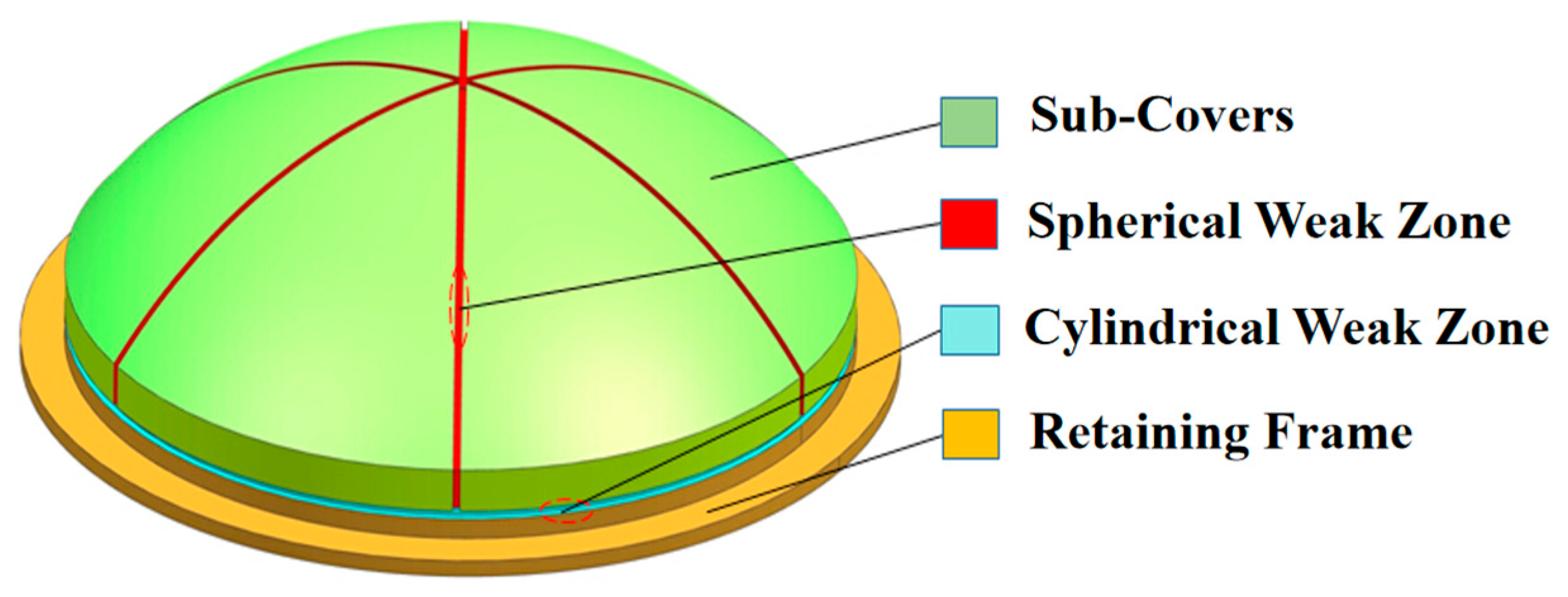
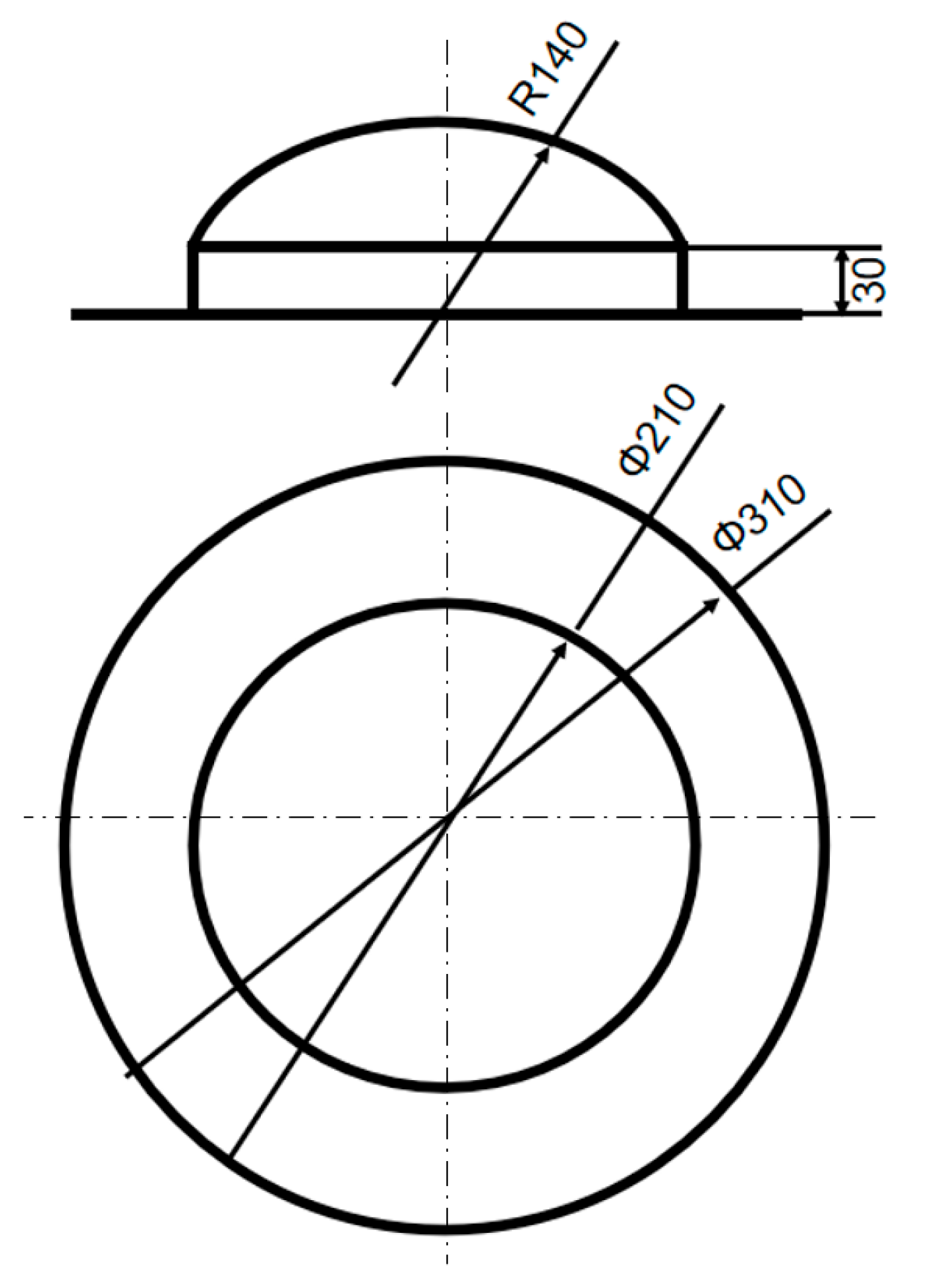
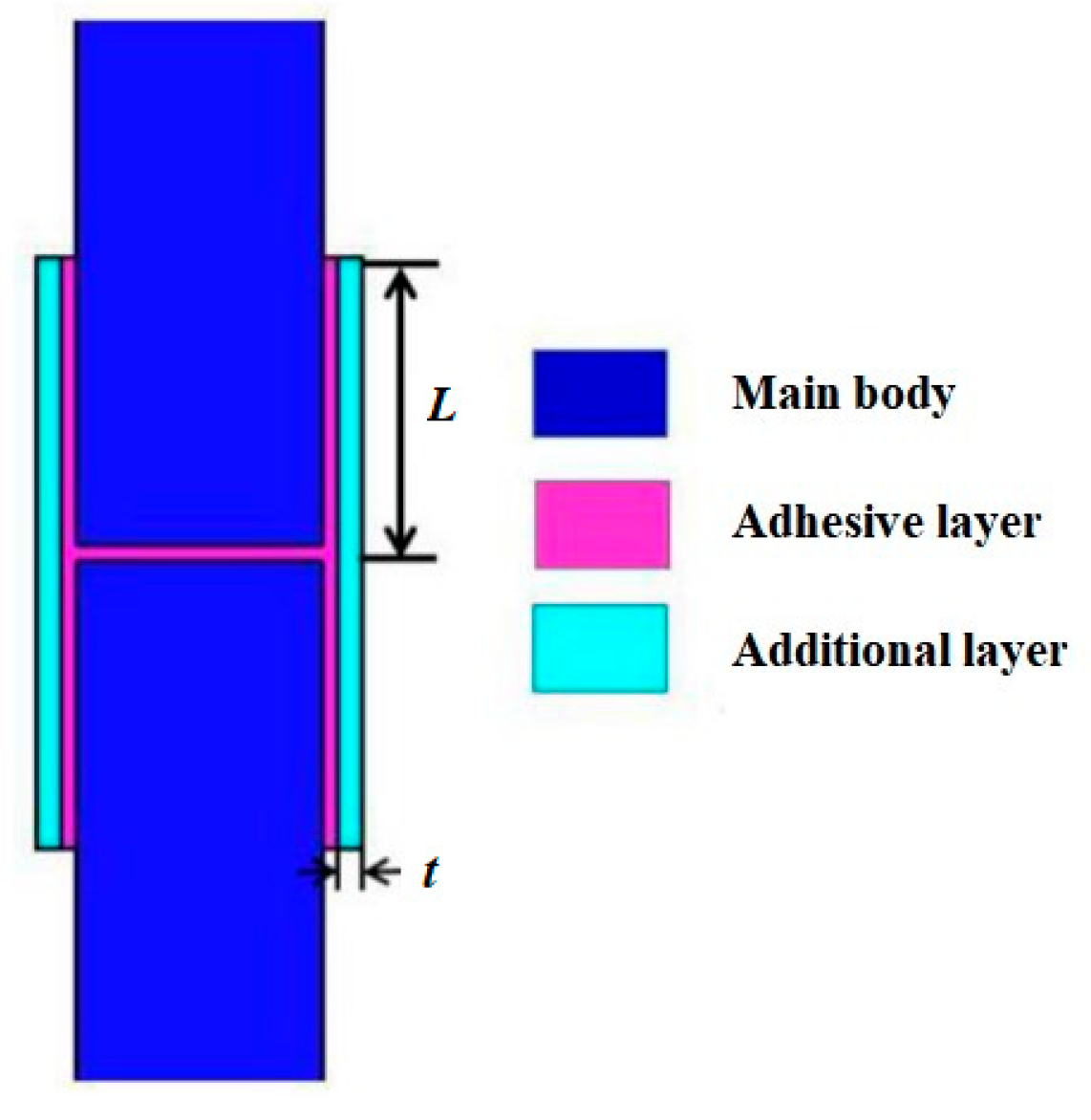

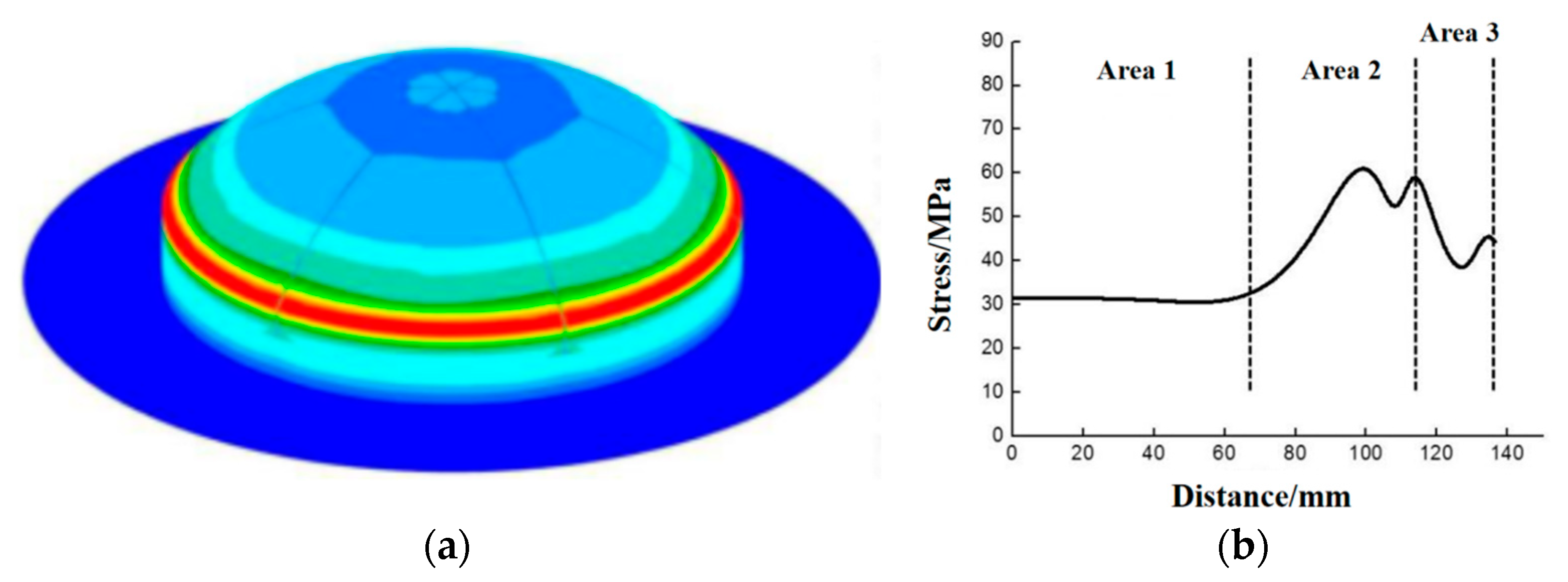
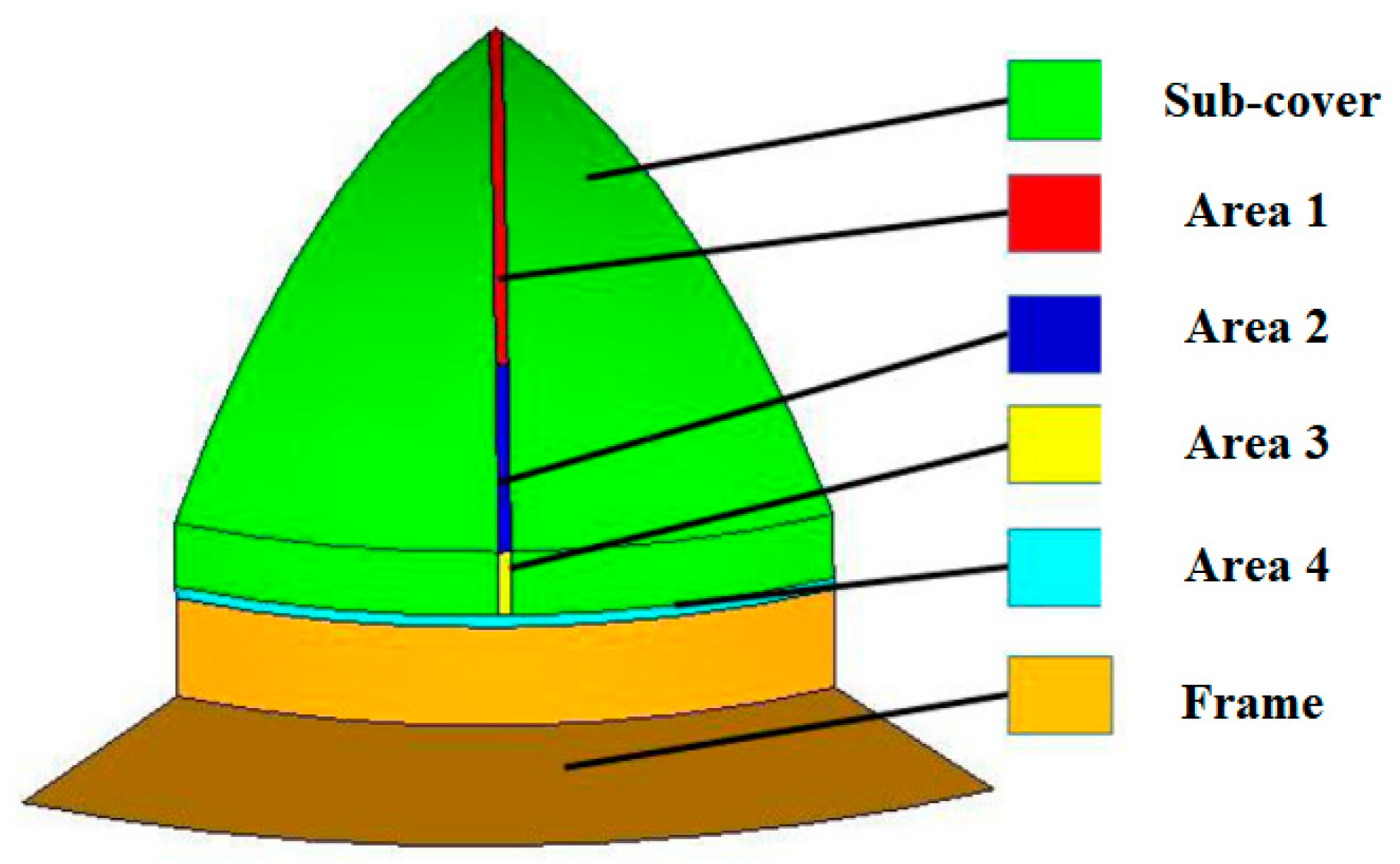
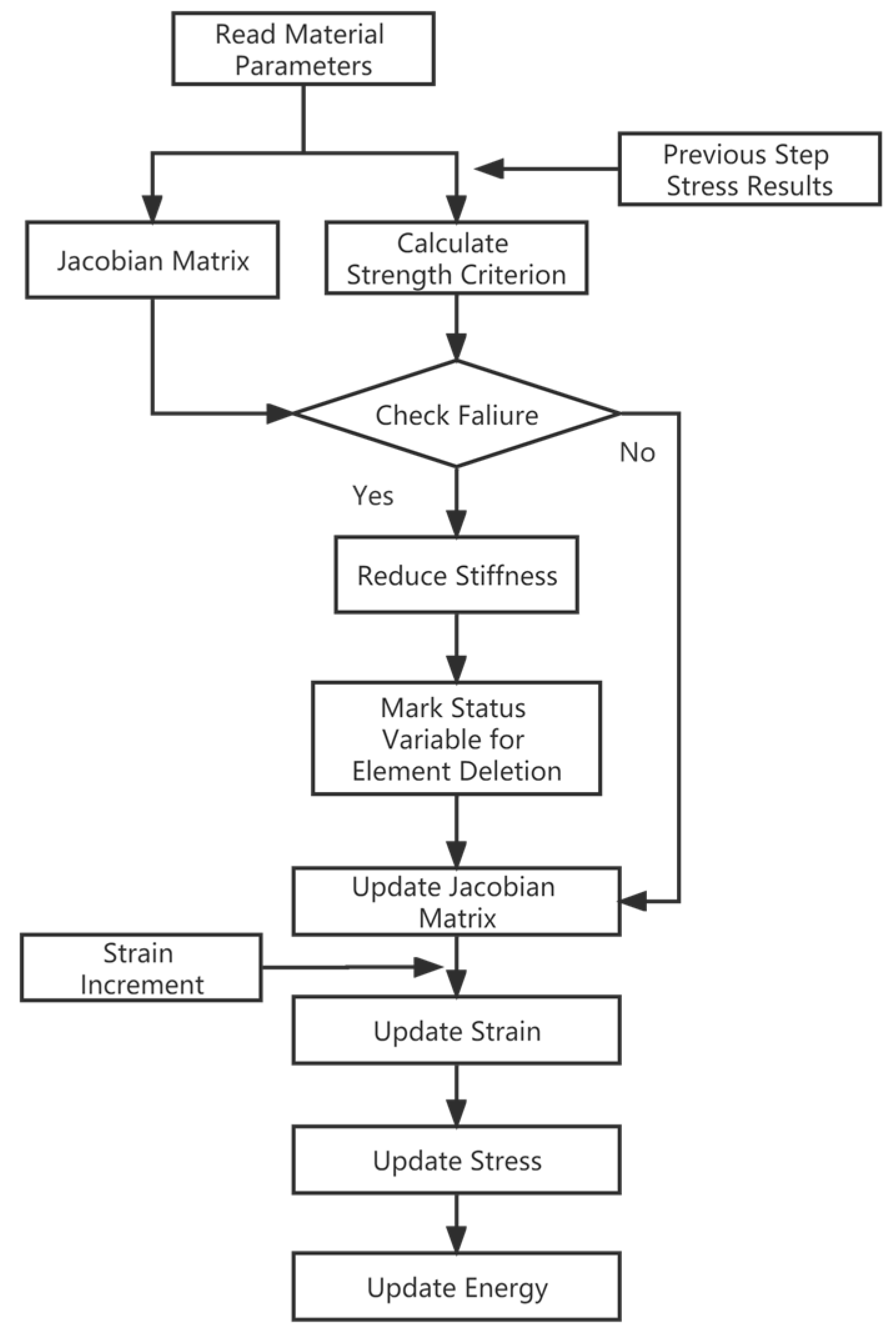
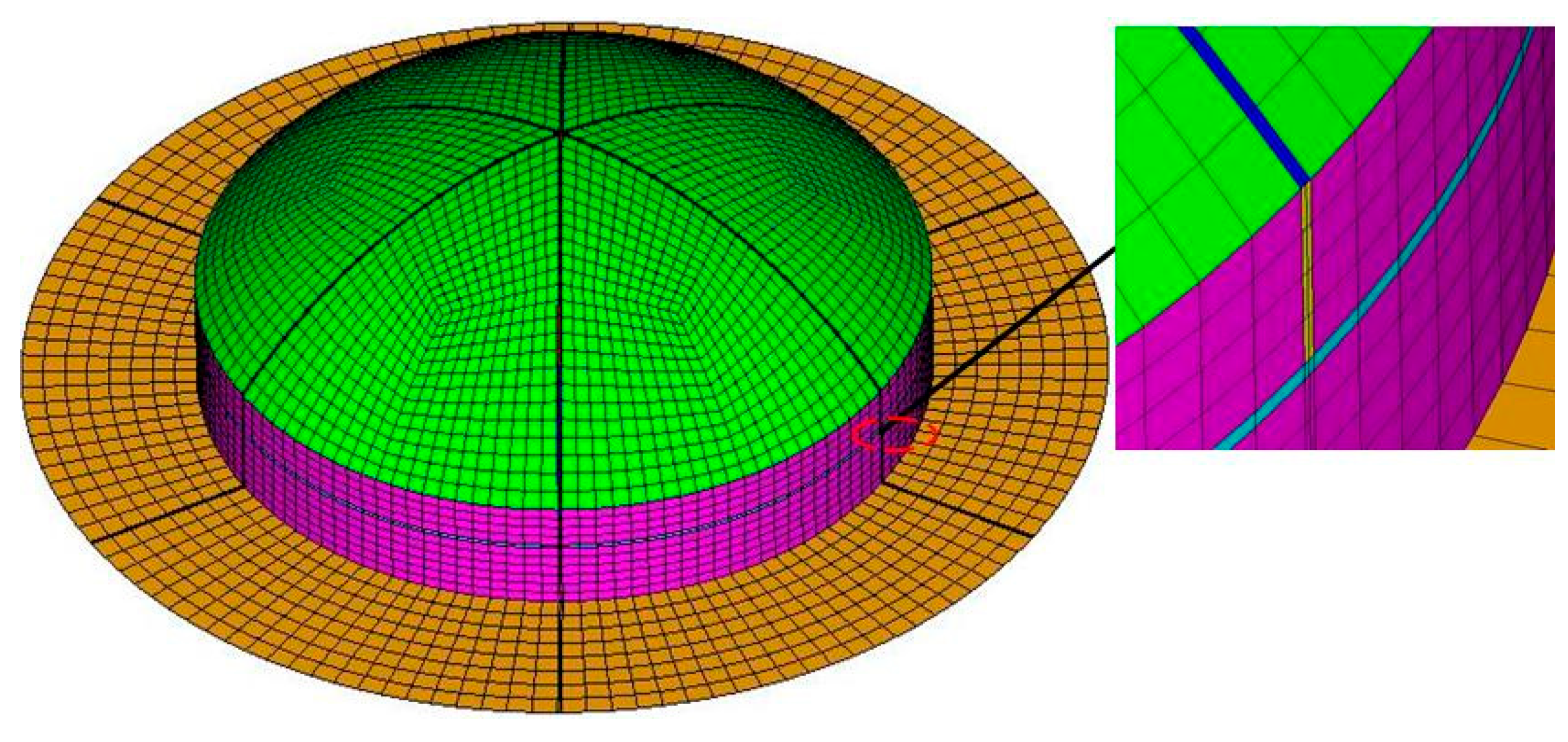
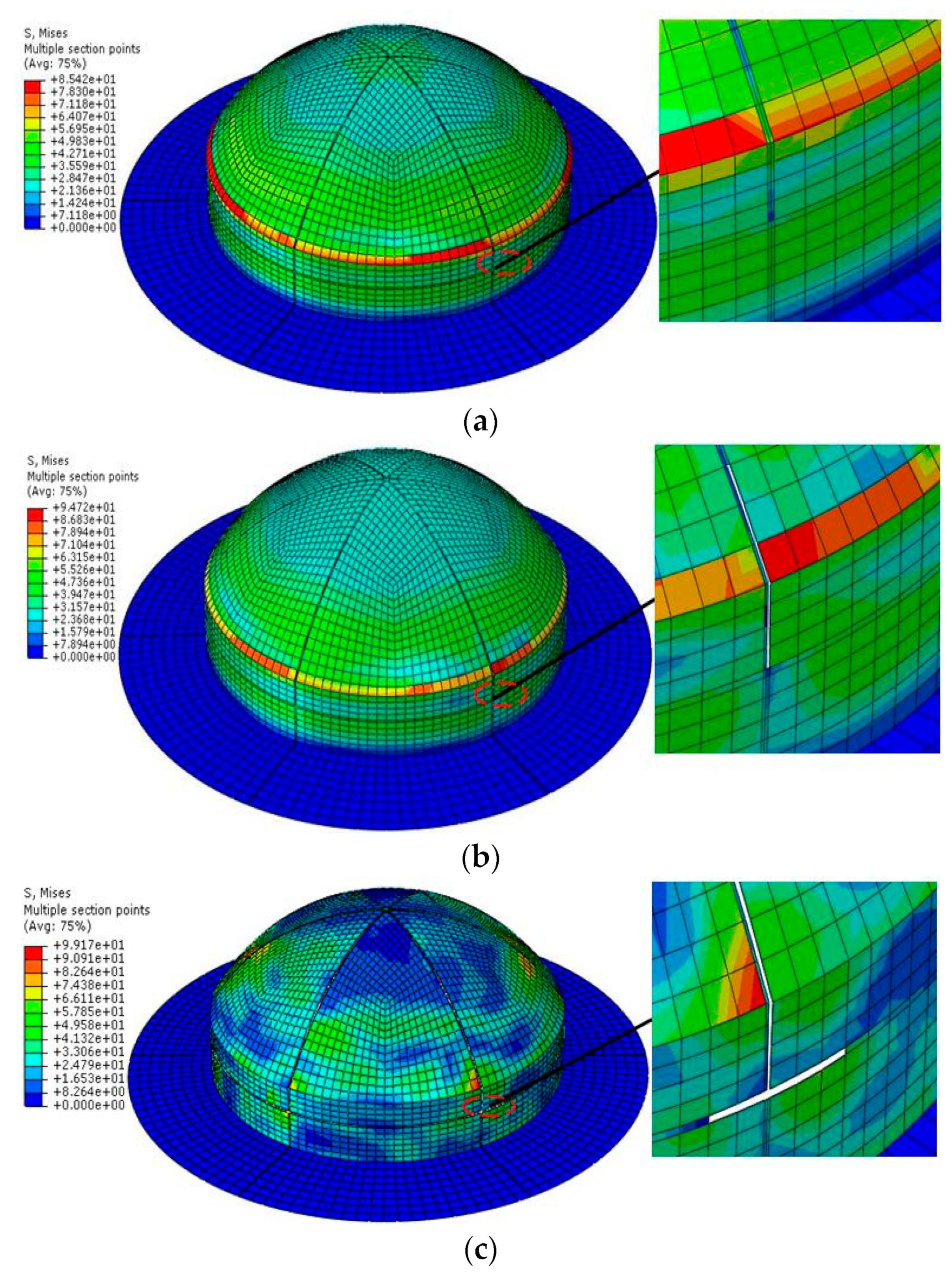



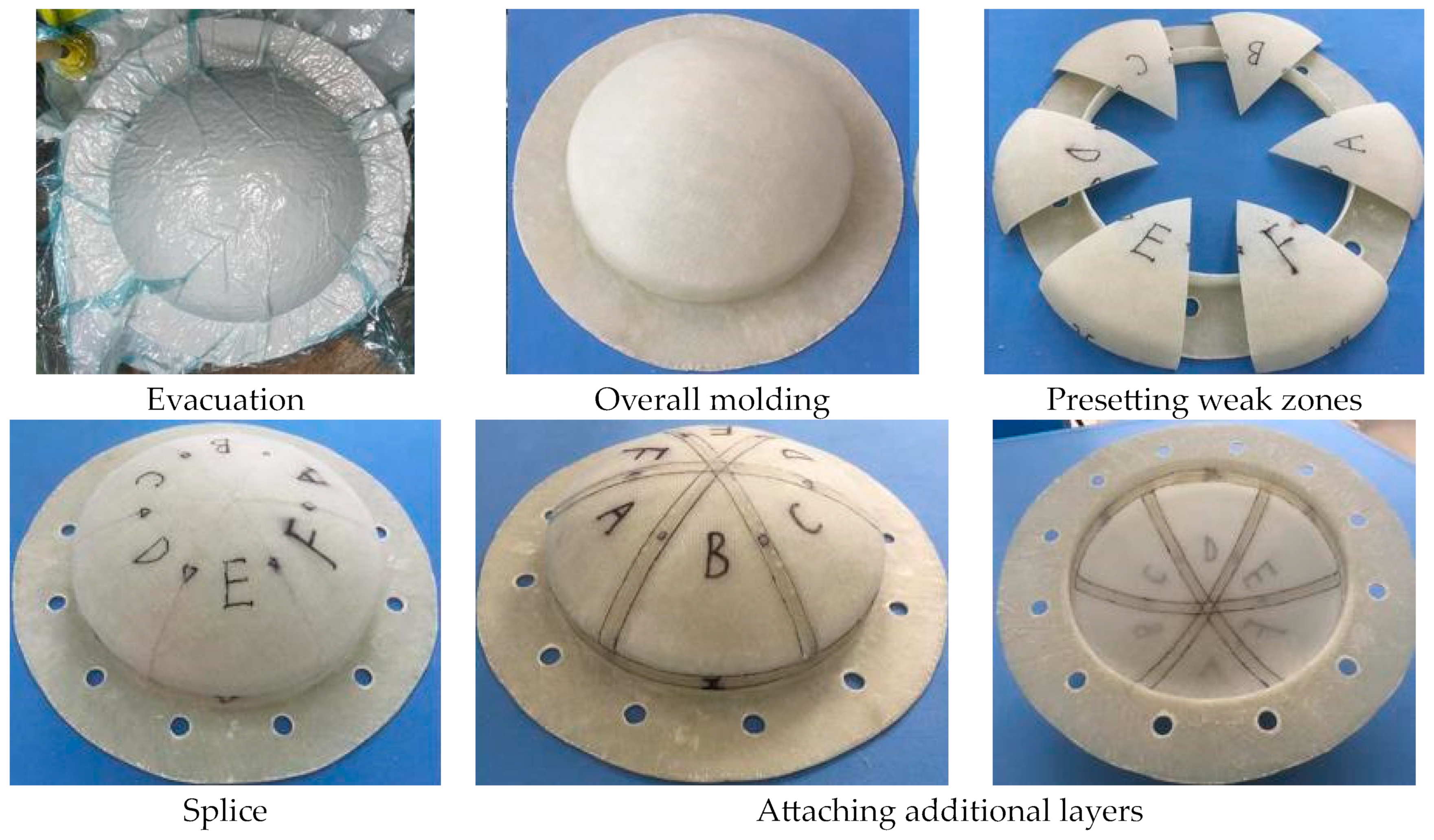

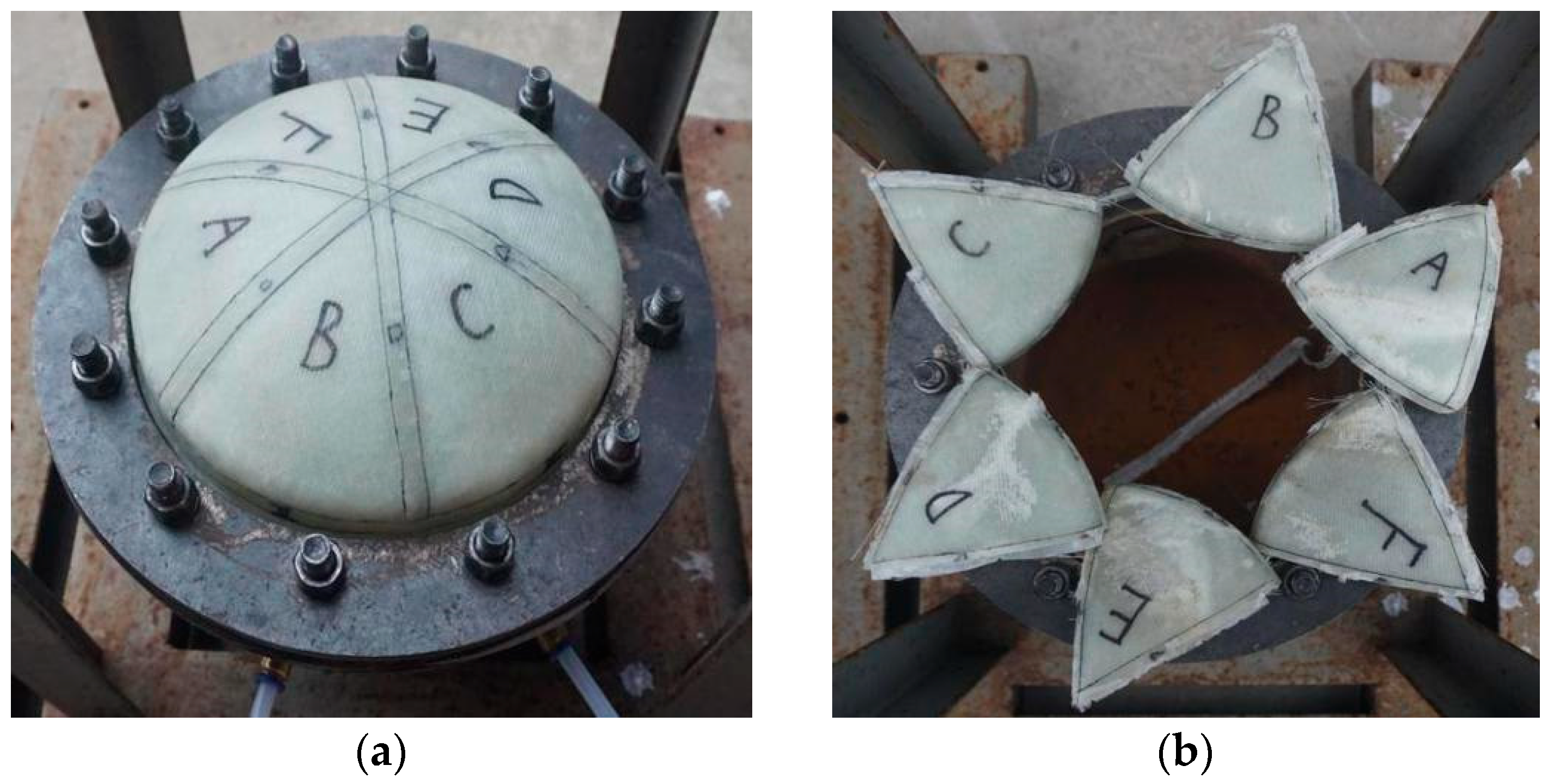
| Weak Zone Type | Area | L/mm | t/mm |
|---|---|---|---|
| Spherical | Area 1 | 4 | 0.1 |
| Area 2 | 6 | 0.2 | |
| Area 3 | 6 | 0.1 | |
| Cylindrical | Area 4 | 4 | 0.2 |
| Area | Spherical Surface | Vertical Surface | Retaining Frame |
|---|---|---|---|
| Thickness/mm | 1.8 | 2.4 | 2.4 |
| Ply numbers | 12 | 16 | 16 |
| Position in the Cover | Ply Angles and Sequences |
|---|---|
| Spherical surface | [03/30/0/30]s |
| Vertical surface | [−302/30/45/03/45]s |
| Frame | [−302/30/45/03/45]s |
| E1/GPa | E2/GPa | μ12 | G12/GPa | Xt/MPa | Xc/MPa | Yt/MPa | Yc/MPa | S/MPa |
|---|---|---|---|---|---|---|---|---|
| 18.89 | 18.89 | 0.11 | 3.31 | 344.91 | 261.52 | 344.91 | 261.52 | 58.82 |
| Test Number | Simulation Pressure/MPa | Test Pressure/MPa | Errors/% |
|---|---|---|---|
| 1# | 0.78 | 0.728 | 7.7 |
| 2# | 0.713 | 8.6 | |
| 3# | 0.722 | 7.4 |
Disclaimer/Publisher’s Note: The statements, opinions and data contained in all publications are solely those of the individual author(s) and contributor(s) and not of MDPI and/or the editor(s). MDPI and/or the editor(s) disclaim responsibility for any injury to people or property resulting from any ideas, methods, instructions or products referred to in the content. |
© 2023 by the authors. Licensee MDPI, Basel, Switzerland. This article is an open access article distributed under the terms and conditions of the Creative Commons Attribution (CC BY) license (https://creativecommons.org/licenses/by/4.0/).
Share and Cite
Qian, Y.; Li, W.; Wang, X.; Cai, D. Design and Analysis of a New Multi-Part Composite Frangible Cover. Polymers 2023, 15, 3307. https://doi.org/10.3390/polym15153307
Qian Y, Li W, Wang X, Cai D. Design and Analysis of a New Multi-Part Composite Frangible Cover. Polymers. 2023; 15(15):3307. https://doi.org/10.3390/polym15153307
Chicago/Turabian StyleQian, Yuan, Wenlong Li, Xiaopei Wang, and Deng’an Cai. 2023. "Design and Analysis of a New Multi-Part Composite Frangible Cover" Polymers 15, no. 15: 3307. https://doi.org/10.3390/polym15153307
APA StyleQian, Y., Li, W., Wang, X., & Cai, D. (2023). Design and Analysis of a New Multi-Part Composite Frangible Cover. Polymers, 15(15), 3307. https://doi.org/10.3390/polym15153307






